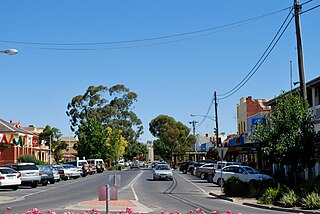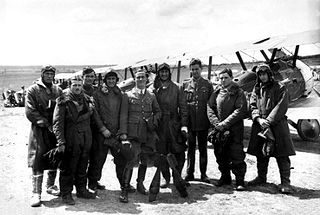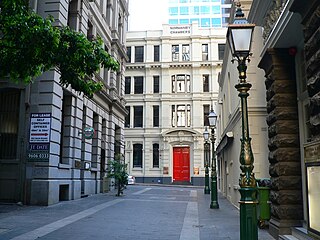
Central Flying School (CFS) is a Royal Australian Air Force (RAAF) training unit, located at RAAF Base East Sale, Victoria. It operates the Pilatus PC-9 turboprop trainer. The school is responsible for training flight instructors, setting flying standards, and auditing flying practices. It is also home to the "Roulettes" aerobatic team. CFS was the first military aviation unit to be formed in Australia, in 1913, when its role was to provide basic flying training. Its current form dates from World War II, when it was re-established to train flying instructors for the Empire Air Training Scheme (EATS).

Cedric Ernest "Spike" Howell, was an Australian fighter pilot and flying ace of the First World War. Born in Adelaide, South Australia, he enlisted in the Australian Imperial Force in 1916 for service in the First World War and was posted to the 46th Battalion on the Western Front. In November 1916, he was accepted for a transfer to the Royal Flying Corps and was shipped to the United Kingdom for flight training. Graduating as a pilot, he was commissioned as a second lieutenant and posted to No. 45 Squadron RFC in France during October 1917; two months later the unit sailed to the Italian theatre.

Wing Commander John Rutherford Gordon was an Australian First World War flying ace credited with fifteen aerial victories while serving as an observer/gunner in the Australian Flying Corps.

Walter Oswald Watt, was an Australian aviator and businessman. The son of a Scottish-Australian merchant and politician, he was born in England and moved to Sydney when he was one year old, returning to Britain at the age of eleven for education at Bristol and Cambridge. In 1900 he went back to Australia and enlisted in the Militia, before acquiring cattle stations in New South Wales and Queensland. He was also a partner in the family shipping firm.
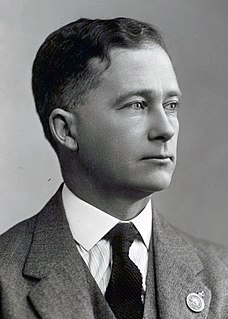
Sir Thomas Walter White, was an Australian politician and First World War pilot. In 1914 he became one of the first airmen trained for the Australian Flying Corps, and among the first to see action when he deployed the following year to the Middle East with the Mesopotamian Half Flight. After carrying out several missions behind Turkish lines, he was captured in November 1915 but escaped in July 1918. He was awarded the Distinguished Flying Cross and twice mentioned in despatches for his war service.

Air Marshal Sir Peter Roy Maxwell Drummond, was an Australian-born senior commander in the Royal Air Force (RAF). He rose from private soldier in World War I to air marshal in World War II. Drummond enlisted in the Australian Imperial Force in 1914 and the following year saw service as a medical orderly during the Gallipoli Campaign. He joined the Royal Flying Corps in 1916 and became a fighter ace in the Middle Eastern theatre, where he was awarded the Military Cross and the Distinguished Service Order and Bar. Transferring to the RAF on its formation in 1918, he remained in the British armed forces for the rest of his life.

Air Vice Marshal Adrian Lindley Trevor Cole, CBE, DSO, MC, DFC was a senior commander in the Royal Australian Air Force (RAAF). Joining the army at the outbreak of World War I, he transferred to the Australian Flying Corps in 1916 and flew with No. 1 Squadron in the Middle East and No. 2 Squadron on the Western Front. He became an ace, credited with victories over ten enemy aircraft, and earned the Military Cross and the Distinguished Flying Cross. In 1921, he was a founding member of the RAAF.

Air Commodore Arthur William Murphy, DFC, AFC, FRAeS was a senior engineer and aviator in the Royal Australian Air Force (RAAF). He accompanied Henry Wrigley on the first trans-Australia flight from Melbourne to Darwin in 1919, a feat that earned both men the Air Force Cross. Murphy later played a leading role in military aircraft maintenance and production.

Captain Sydney Dalrymple, was an Australian First World War flying ace, credited with five aerial victories while serving in the British Royal Flying Corps and Royal Air Force.
Lieutenant Thomas Henry Barkell was an Australian flying ace of the First World War, credited with seven aerial victories.

Eric Harrison was an Australian aviator who made the country's first military flight, and helped lay the groundwork for the Royal Australian Air Force (RAAF). Born in Victoria, he was a flying instructor in Britain when, in 1912, he answered the Australian Defence Department's call for pilots to form an aviation school. Along with Henry Petre, he established Australia's first air base at Point Cook, Victoria, and its inaugural training unit, the Central Flying School (CFS), before making his historic flight in March 1914. Following the outbreak of World War I, when Petre went on active service with the Mesopotamian Half Flight, Harrison took charge of instructing student pilots of the Australian Flying Corps at CFS.
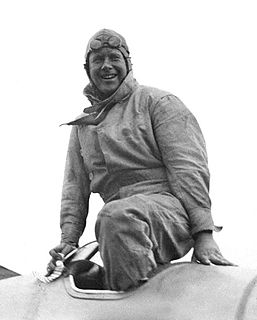
Leslie Hubert (Les) Holden, MC, AFC was an Australian fighter ace of World War I and later a commercial aviator. A South Australian, he joined the Light Horse in May 1915, serving in Egypt and France. In December 1916, he volunteered for the Australian Flying Corps and qualified as a pilot. As a member of No. 2 Squadron on the Western Front, he gained the sobriquets "Lucky Les" and "the homing pigeon" after a series of incidents that saw him limping back to base in bullet-riddled aircraft. He was awarded the Military Cross, and went on to achieve five aerial victories flying Airco DH.5s and Royal Aircraft Factory S.E.5s.
Captain Arthur Whitehair Vigers was a British World War I flying ace credited with 14 aerial victories. He was the third ranking of the 27 aces who flew the Sopwith Dolphin, and the highest scoring ace in his squadron.

Henry Garnet Forrest, was an Australian First World War flying ace, credited with eleven aerial victories while serving in the Australian Flying Corps.
George Henry Fraser was a navigator and aircraft mechanic who flew with pilot Cedric Howell as one of the teams competing in the England to Australia air race in December 1919. Howell and Fraser's aircraft made a forced landing in the St George's Bay, Corfu; both men are presumed to have drowned as a result, although only Howell's body was ever recovered.
Edgar Garfield Finlay, was an Australian flying ace of the First World War. He served with distinction in the Gallipoli Campaign as a noncommissioned officer in the Light Horse. After transferring to the Australian Flying Corps, he was commissioned and served as an aerial observer. In this role he was credited with eight aerial victories before training as a pilot.

Henry Bachtold DSO MC was an Australian soldier and railway engineer. He fought during World War I as an engineer with the 1st Field Company at the Gallipoli Campaign, where he was mentioned in despatches and awarded the Military Cross. He commanded the 14th Field Company at the Battle of Polygon Wood, for which he was appointed a Companion of the Distinguished Service Order. Bachtold commanded the engineers of the 5th Australian Division in 1917–18 and the engineers of the 3rd Australian Division in 1918. He was mentioned in dispatches four times during World War I and ended the war as a lieutenant colonel. During 1942 and 1943, Bachtold was the Chief Engineer of II Corps, after which he was placed in reserve with the honorary rank of brigadier. Bachtold retired from the Department of Railways New South Wales in 1962 and died on 9 May 1983.
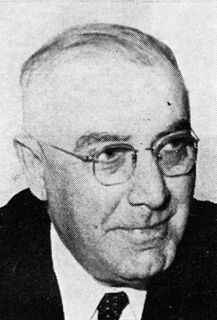
Wilfred Arthur Baird (1889–1954), also known as Wilfred Arthur Beard, was the first chief engineer of the Australian airline Qantas. He established Qantas's reputation for excellence in engineering.
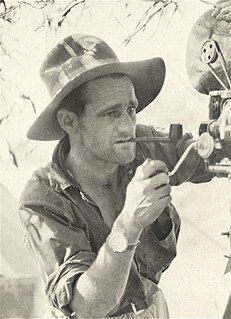
Ernest Gustav Brandon-Cremer was a New Zealand/Australian moviemaker, newsman, explorer and adventurer. He was a key figure in Australian aviation history, and was especially known for his documentation of Lasseter's Gold Reef as well as his photography of the Solar eclipse of 21 September 1922 at Wallal, Australia.

Lieutenant-Colonel Edgar Hercules Reynolds OBE commanded the Australian Flying Corps (AFC) during World War I. Reynolds' role was mostly administrative, as AFC squadrons were usually subordinate to Australian ground forces or British air commands.



